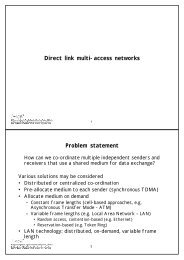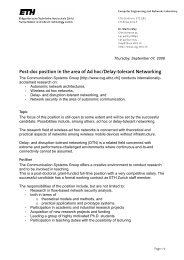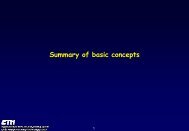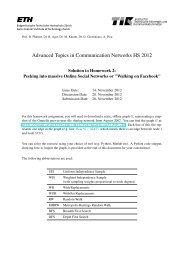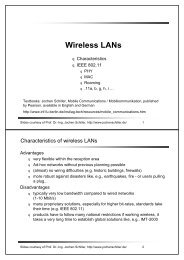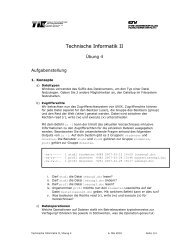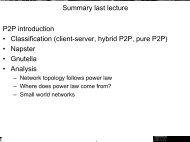Exam Communication Networks - Communication Systems Group
Exam Communication Networks - Communication Systems Group
Exam Communication Networks - Communication Systems Group
You also want an ePaper? Increase the reach of your titles
YUMPU automatically turns print PDFs into web optimized ePapers that Google loves.
Institut fürTechnische Informatik undKommunikationsnetzeDepartment ITETLecture SS 2004Lecturer: Prof. B. PlattnerCoordinator: Thomas Dübendorfer<strong>Exam</strong><strong>Communication</strong> <strong>Networks</strong>8. March 2005, 09:00 – 12:00, HG D1.1General Remarks:⊲ Put your legitimation card on your desk.⊲ Write your name and your ETH student number on this front page.⊲ Control if you have received all task sheets (Pages 1 - 13).⊲ Use a new sheet of paper for each task.⊲ Write your name and the exam task number in the upper right corner on each papersheet that contains your solutions (1 point).⊲ Read each task completely before you start solving it.⊲ Cancel invalid parts of your solutions clearly.⊲ At the end of the exam, hand your solutions in together with all tasks.⊲ Do no separate the task sheets.⊲ For the best mark, less than all points are necessary.Special aids:⊲⊲All written material (vocabulary books, lecture and lab scripts, exercises etc.) is allowed.Use of electronic communication tools (mobile phone, computer etc.) is strictly forbidden.Family name:Student legi nr.:First name:Signature:Do not write in the table below (use by correctors only):Task Points Sig.Name on each sheet /11 /212 /183 /194 /205 /206 /207 /20Σ /139
Lecture SS 2004 <strong>Communication</strong> <strong>Networks</strong> 2Task 1: General Questions21 Pointsa) Applications (5 Points)Check either true, false or nothing. Each correct answer gives one point. For each falseanswer one point is subtracted. No answer gives zero points. This subtask gives at leastzero points.true□true□true□true□true□false□false□false□false□false□A JPEG image encoded to be transported with SMTP (RFC 821) increasesin size.SMTP allows a mail reader application to choose whether received messagesshould be stored locally or left in the mailbox (inbox) of the mail daemon.A web browser must request a cached web page using the HEAD operationin order to find out whether a later/modified version of the page is on theweb server.The POST method in HTTP replies can be employed to send form input.HTTP 1.1 offers persistent connections to improve the download speed byexchanging HTTP request and response messages over multiple TCP connectionsbetween a client and a server.b) Framing and Stuffing (5 Points)(i) Name two reasons why data streams that are transported over a shared medium haveto be packetized into frames with limited size.(2 Points)(ii) Assuming a properly working HDLC encoder, give a bit sequence that will never begenerated.(1 Point)(iii) Given the following bit sequence generated by an HDLC encoder:00110101111011111001111110001111100101101010Derive the payload data associated with this sequence of bits. Mark any bits in thesequence above that have to be removed/changed/added and describe what is to bedone with the bits.(2 Points)c) Ethernet (IEEE 802.3) (11 Points)(i) Ethernet is said to be a CSMA/CD local area network technology. CSMA means thata node intending to send a frame can sense whether the shared transmission medium isbusy or idle. Explain briefly why ”CD” is used and how CSMA-based networks copewith the missing CD functionality.(2 Points)(ii) Why is CSMA/CD preferred over CSMA?(1 Point)(iii) Your company wants to develop an CSMA/CD network, the 3G Ethernet, with thefollowing specifications:• Maximum distance between two nodes: 5000 m• Maximum number of repeaters/hubs between segments: 2• Maximum number of switches between segments: 3• Maximum delay of repeater: 20 µs• Maximum delay of switch: 30 µs• Bit rate: 3000 MbpsHow would you choose the minimal size of a 3G Ethernet frame? Which additionalparameter do you need to know?(8 Points)
Lecture SS 2004 <strong>Communication</strong> <strong>Networks</strong> 3Task 2: Medium Access18 Pointsa) Radia Perlman Spanning Tree Algorithm (8 Points)In the following figure, LANs are represented by bold lines and bridges are representedby circular nodes. The bridges are labelled B1,B2,... ,B5 and the LANs are labelledL1,... ,L6. The Radia Perlman Spanning Tree algorithm (STA) is used in all the networks.The labels of the bridges in the figure are the unique identifiers used by STA. The identifiersare lexicographically ordered, i.e., B1 < B2 < ... < B5. In your answers, use Bx-Ly toindicate a path of the spanning tree between bridge Bx and LAN Ly.B1L1 L2 L3B4B5B2L6L4B3L5(i) Which spanning tree is computed by STA?(2 Points)(ii) Let us now assume that bridge B2 gets permanently disconnected from LAN L3. Whichbridges will, as a consequence of this, start to advertise itself as root and why?(4 Points)(iii) Which new spanning tree will be computed by STA with B2 disconnected from L3?(2 Points)b) Wireless LAN & MACAW (10 Points)Consider the following scenario of five WLAN nodes. Each node has the same range as nodeA (in the figure only the range of node A is shown). Each node can send and receive signalsdirectly only with its immediate neighbors to the left and to the right.A B C D E(i) Explain with an example what it means that node B and node D are hidden nodes withrespect to each other?(2 Points)
Lecture SS 2004 <strong>Communication</strong> <strong>Networks</strong> 4(ii) Describe a situation in which node D is an exposed node.(2 Points)(iii) Suppose that node C is sending to node D. Node B, while in the range of node C, cantransmit to node A without any problems. How exactly does B get to know this whenusing the MACA algorithm?(2 Points)(iv) To enable RTS/CTS on access points, one usually sets a specific packet size threshold (0– 2347 bytes) in the user configuration interface. If the packet that the access point istransmitting is larger than the threshold, it will initiate the RTS/CTS function. Assumethat you are in an environment where collisions occur very seldomly. How would youset the packet size threshold and why?(2 Points)(v) How does the MACAW algorithm extend the original MACA algorithm? Why is thisextension useful in wireless networks?(2 Points)
Lecture SS 2004 <strong>Communication</strong> <strong>Networks</strong> 6Task 4: Routing20 Pointsa) Hot-Potato Routing (6 Points)The figure below depicts two autonomous Internet domains (owned by two providers), whichare interconnected via the peering links L1 and L2. The circles within the domains arerouters. Router A (in Domain A) connects Host1 and Router J (in Domain B) connectsHost2 to the Internet. We assume the routing policy followed in each domain is to minimizethe number of hops within the domain.Host1ADomain ADL1EL2NXDomain BZJHost2Figure 1: Network Topology(i) Host1 downloads a 10 GByte file from Host2 via FTP. Which traffic will be observedon peering link L1 and which on link L2?(2 Points)(ii) During the download the link between Router J and Router Z experiences severe congestion.How may this influence the download?(1 Point)(iii) What can the providers do in order to improve above situation? Make two proposals.(3 Points)b) Load Balancing and Tunneling (10 Points)For this task we consider Domain B only. Keep your solutions short by stating only yourcore ideas. We do not require lengthy explanations for this subtask.(i) Router J supports two mutually exclusive load balancing mechanisms. Mechanism a.)works on packet level, i.e. it tries to put packets evenly on the links. Mechanism b.)works on connections, i.e. it tries to evenly distribute the number of connections on thelinks. Compare both mechanisms in respect to complexity, traffic load distribution, andimpact on TCP protocols.(6 Points)(ii) An alternative to load balancing at router level consists in setting up bidirectional tunnelsbetween all the routers at the edge of a network and distribute the entering trafficaccordingly. How many tunnels will a provider with n edge routers have to set up?(2 Points)(iii) Name two drawbacks of the tunneling approach.(2 Points)c) General Questions (4 Points)(i) BGP Routing table sizes have doubled from 1999 to 2004, although the number ofnew networks grew by far less a rate. From this we deduce, that logical networks (asaggregated by CIDR for example), are not advertised as a single entry. What is themotivation for a large Internet provider to announce his network as several smallernetworks?(2 Points)(ii) Source routing allows a host to explicitly define the route a packet has to take. Name acase where source routing could be useful. Name a disadvantage of source routing.(2 Points)
Lecture SS 2004 <strong>Communication</strong> <strong>Networks</strong> 7Task 5: Transport Layer20 Pointsa) TCP (Transmission Control Protocol) (6 Points)You are assigned to design a reliable byte-stream protocol that uses a sliding window mechanism(like TCP) which will be used for several experiments over the 1 Gbps network at theinstitute’s lab. Assuming that the RTT of the network is 100 ms, respond to the followingquestions:(i) A colleague of you states that 8 bits for the AdvertisedWindow field (to encode thenumber of available bits in the receiver’s buffer) are enough in order not to waste headerresources. Explain whether 8 bits are an appropriate solution and calculate how manybits you would include in the AdvertisedWindow header field of your protocol for anoptimal solution?(3 Points)(ii) If the SequenceNum field is 32-bit, which MSL (Maximum Segment Lifetime) valuedo you recommend in order to protect your protocol against wrap-around? Explain youranswer.(3 Points)b) TCP Congestion Control (14 Points)The TCP congestion control mechanism is used by each source to determine the availablecapacity in the network. TCP for that purpose maintains the CongestionWindow statevariable. Figure 4 (A) traces TCP’s CongestionWindow variable over time. In order torespond the following questions, it might help to first identify the time intervals representingslow start on startup, slow start after timeout, and linear increase congestion avoidance.(i) At which time instants do timeouts occur?(2 Points)(ii) Give the approximate value of the CongestionThreshold variable at time instants t=1.0s, t=4.0 t=6.0 s and t=8.0 s. Assume it to be 40 kBytes at t=1.0 s. (2 Points)(iii) Trace the CongestionWindow variable over time in Figure 4, when the FastRetransmitmechanism is used in TCP congestion control in (B) and when both the FastRetransmitand the FastRecovery algorithm are used in (C). In both cases we assume that the sourceidentifies and considers packet loss(es) at the time instants t=0.9 s, t=5.5 s and t=7.5s. Subsequently, answer the questions (i) and (ii) for both mechanisms. You can assumethat the advertised window size will never be reached.(10 Points)
Lecture SS 2004 <strong>Communication</strong> <strong>Networks</strong> 8A)5040KB3020101.0 2.0 3.0 4.0 5.0 6.0 7.0Time (seconds)8.0 9.0B)5040KB3020101.0 2.0 3.0 4.0 5.0 6.0 7.0Time (seconds)8.0 9.0C)5040KB3020101.0 2.0 3.0 4.0 5.0 6.0 7.0Time (seconds)8.0 9.0Figure 2: TCP’s CongestionWindow variable over time
Lecture SS 2004 <strong>Communication</strong> <strong>Networks</strong> 10• The Internet should be accessible for hosts in the internal network only to access webservers.• Hosts in the DMZ should not be able to initiate connections to the Internet nor to theinternal network.According to these requirements, give appropriate stateful rules in an iptables-like syntaxfor:(i) Firewall FW1(ii) Firewall FW2(4 Points)(4 Points)
Lecture SS 2004 <strong>Communication</strong> <strong>Networks</strong> 11Task 7: DNS20 Pointsa) DNS Setup (6 Points)You are the administrator of SmartCompany (smart.com) responsible for the Internet serviceinfrastructure of the company. SmartCompany runs its own web-, mail- and name-server ona set of 8 static IP-Addresses (111.10.20.0-111.10.20.7) provided by local ADSL providerBigProvider. For redundancy, an affiliated company of SmartCompany provides backupservices.File 1 (smart.com): /var/named/zone/smart.com$TTL 3600@ IN SOA ns.smart.com. adm.smart.com. (2002022401 ; serial3H ; refresh (hours)15 ; retry (minutes)1w ; expire (weeks)3h ; minimum (hours))IN NS ns.clever.com.IN NS ns.smart.com.@ IN A 111.10.20.3www IN A 111.10.20.5upload IN A 111.10.20.5ns.smart.com. IN A 111.10.20.1ns.clever.com. IN A 222.80.90.1ftp IN CNAME smart.com.web IN CNAME smart.com...(i) What is the contact e-mail address of the person responsible for the zone smart.com?(1 Point)(ii) What is the IP address (if any) of the host ftp.smart.com? (1 Point)(iii) What is the IP address (if any) of the host www.smart.com? (1 Point)(iv) What are the FQDN (fully qualified domain name) and IP addresses of the primary andsecondary nameservers for the zone smart.com? Clearly indicate which is the primaryand which is the secondary nameserver. (1 Point)(v) The above zone-file File 1 for smart.com is incomplete with respect to informationneeded for correct handling of e-mail. Fill the missing lines needed in File 1 to makemail.smart.com (111.10.20.2) the default mailserver and backup.clever.com (222.80.90.2)the fallback mailserver for @smart.com. (2 Points)____________________________________________________________________________________________________________________________________________________________________________________________________________________________________________________________________b) Reverse Lookup (5 Points)You decide that reverse lookups on the mail-server IP address 111.10.20.2 should be answeredwith mail.smart.com.Check either true, false or nothing. Each correct answer gives one point. For each falseanswer one point is subtracted. No answer gives zero points. This subtask gives at least
Lecture SS 2004 <strong>Communication</strong> <strong>Networks</strong> 12zero points.On what nameserver(s) does the configuration need a change?true□true□true□true□true□false□false□false□false□false□on the primary nameserver of SmartCompany.on the secondary nameserver of SmartCompany.on the nameserver of BigProvider as this is the owner of the IP addressblock assigned to SmartCompany.on at least one of the root-nameservers.No change is needed, as the reverse resolution information is already definedthrough the A records.c) Outsourcing (5 Points)Due to the high popularity of your online-shop www.smart.com and the potential loss ofmoney should the webserver experience any downtime, you decide to outsource this webservice.You choose to change the www.smart.com service to AlwaysUp a hosting companyspecialized in high availability hosting. All other services remain with BigProvider. AlwaysUpassigns you the new IP address for your webshop: 101.11.1.33.(i) Write down all changes needed in the zone smart.com (File 1) to reflect the change toAlwaysUp as stated above. (2 Points)____________________________________________________________________________________________________________________________________________________________________________________________________________________________________________________________________(ii) On Friday, 09:00h you update your primary nameserver ns.smart.com. What is themaximum delay for the secondary nameserver to update its copy of the zone smart.com?Assume that the secondary nameserver is configured to automatically check for updatesaccording to the information in the SOA record and that there are no transmissionerrors. (1 Point)d) Domain Name System (4 Points)You decide to create a secure web-message service for you and your friends. As the domainnameof choice message.com is already registered, you create your own top level domain(TLD) .sec. You are authorized to create the message.sec zone on the primary and secondarynameservers of ETHZ, assigning the IP address 111.10.20.6 to www.message.sec.You then setup and run a webserver on www.message.sec.Check either true, false or nothing. Each correct answer gives 0.5 points. For each falseanswer 0.5 points are subtracted. No answer gives zero points. This subtask gives at leastzero points.The term this works means that the local machine can resolve www.message.sec to its IP.Assume the local machines gets all networking settings by dhcp from the local network.true□true□true□true□false□false□false□false□It is not possible to create a zone with a new TLD on a nameserver asanybody could drive the Internet havoc with such unauthorized entries.The nameservers refuse to load such a zone.DNS resolvers on the local machines would refuse to resolve a new TLD.http://www.message.sec works within the ETHZ network, but not outside.http://www.message.sec works from Starbucks in Copenhagen/Denmark.
Lecture SS 2004 <strong>Communication</strong> <strong>Networks</strong> 13true□true□true□true□false□false□false□false□http://www.message.sec works from CNN in Atlanta/USA.This works globally as long as your nameserver knows the IP addresse of aleast one root-nameserver.This works from anywhere in the world if the local machine has set theETHZ nameservers as default nameserver.This works from anywhere in the world as the ETHZ nameservers are correctlyregistered with Switch, one of the TLD registrars.




